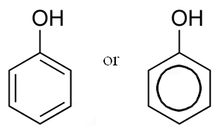In my previous blog, I wrote that Salicylic Acid is a monohydroxybenzoic acid. This means that it is a type of phenolic acid and a beta hydroxy acid. To see my previous post click here.
Phenol
Phenol, which is the parent compound of phenolic compounds is used as a disinfectant and for chemical synthesis. Phenolics are a class of chemical compounds consisting of a hydroxyl functional group (-OH) attached to an aromatic hydrocarbon group. The simplest of the class is phenol (C6H5OH). Some phenols are germicidal and are used in formulating disinfectants. Others possess estrogenic or endocrine disrupting activity. (click here)
Phenolic Compounds
Phenolic compounds are a large and diverse group of molecules which includes many different families of aromatic secondary metabolites in plants. These phenolics are the most abundant secondary metabolites in plants and can be classified into non-soluble compounds such as condensed tannins, lignins, cell-wall bound cell-wall bound hydroxycinammic acids, and soluble compounds such as phenolic acids, phenylpropanoids, flavonoids and quinones. All these groups are involved in many processes in plants and animals. (click here)
Phenolic Acid
Phenolic acid is a plant metabolite which is widely spread throughout the plant kingdom. Phenolic acid is essential for the growth and reproduction of plants. It is produced as a response for defending injured plants against pathogens.
Natural Substances with Phenolic Acids
1. Propolis
The pharmacologically active molecules in the propolis are flavonoids and phenolic acids and their esters. These components have multiple effects on bacteria, fungi and viruses. In addition, propolis and its components have anti-inflammatory and immunomodulatory activities.
2. Coffee
Coffee is very rich in bound phenolic acids such as caffeic acid, ferulic acid and p-coumaric acid.
3. Purple corn maize
4. Quince
5. Aloe Ferox
6. Berries
7. Spices
Spices significantly contribute to the flavor, taste, and medicinal properties of food because of phenolics. Most spices contain phenolic acids such as tannic, gallic, caffeic, cinnamic, chlorogenic, ferulic and vanillic acids. A high amount of tannic and gallic acids are found in black mustard and clove. Caffeic, chlorogenic and ferulic acids are found in a good amount in cumin. Vanillic and cinnamic acids are found in onion seeds.
8. Dark Plum
9. Cherry
10. Apple (Valkea Kuulas)
11. Green & Black Teas
12. Horse Gram Beans
13. Mushroom (Basidiomycetes species)
14. Chillli Peppers
Capsaicin which is the pungent compound.
15. Herbs
16. Dried Fruits
17. Strong Smells/Aroma
18. Red Wine
18. Red Wine
Some Phenolic Compounds
BHT (Butylated Hydroxytoluene) - A fat-soluble antioxidant and food additive
Cresol - Found in coal tar and creosote
Estradiol - Estrogen (hormones)
4-Nonylphenol - A breakdown product of detergents and nonoxynol-9
Orthophenyl Phenol - A fungicide used for waxing citrus fruits
Porpofol - An anesthetic
Raspbery Ketone - A compound with an intense raspberry smell
Thymol - An antiseptic used in mouthwashes
Xylenol - Used in antiseptics and disinfectants
For a full list of phenolic compounds click here.

Do you find you are sensitive to all of these things then?
ReplyDeleteI am not sure. Maybe that is why I am so sensitive to smells? Even the smell of coffee makes me sick. I am still learning and figuring things out!
DeleteInteresting!! I was once told by an allergist that the allergy test I had for grass swelled up when I got around perfume because grass and perfume are both phenols. I had no idea what that meant. This sheds some light...
ReplyDeleteThis is so interesting!! thanks for sharing... especially the MC Survivor comment- grass and perfume both Phenols...
ReplyDeletethanks for sharing
Have you tried the supplement "No-Fenol"? It has been very helpful for many with salicylate/phenol sensitivity. A google search will turn up more information...
ReplyDeleteI will read up on it. Thanks Danny!
Delete